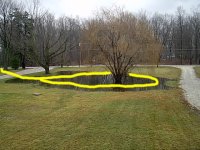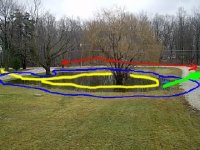Dave___in___CT
Gold Member
- Joined
- Oct 7, 2003
- Messages
- 481
- Location
- West-Central CT
- Tractor
- Kubota L3130, LA723 Loader, BH90 Backhoe, Curtis Cab, || '82 Gravely 8199KT garden tractor
</font><font color="blue" class="small">( ...
For my solution, the theory was that the surface soils were less permeable than one of the lower soil levels so I dug a 14 ft. deep hole at the lowest spot and filled that hole with large rocks from the basement excavation.
If you have a porous layer under there somewhere, connecting it to the surface would speed the drainage.
John )</font>
This seems a decent possibility....
At my previous place... had shallow standing water similar to yours...
some topsoil... then clay under it...
It wasn't an issue for me... in the back yard woods...
OK... so I asked the excavator dig a small pond...
About 4' down up came clear sand ! /forums/images/graemlins/shocked.gif
So much for the pond ! It all drains now !
Only way is to explore what's underneath the surface...
If it dosen't work out... just fill the hole with the excavated material...
Or... make a huge drywell...
Dave...
For my solution, the theory was that the surface soils were less permeable than one of the lower soil levels so I dug a 14 ft. deep hole at the lowest spot and filled that hole with large rocks from the basement excavation.
If you have a porous layer under there somewhere, connecting it to the surface would speed the drainage.
John )</font>
This seems a decent possibility....
At my previous place... had shallow standing water similar to yours...
some topsoil... then clay under it...
It wasn't an issue for me... in the back yard woods...
OK... so I asked the excavator dig a small pond...
About 4' down up came clear sand ! /forums/images/graemlins/shocked.gif
So much for the pond ! It all drains now !
Only way is to explore what's underneath the surface...
If it dosen't work out... just fill the hole with the excavated material...
Or... make a huge drywell...
Dave...


